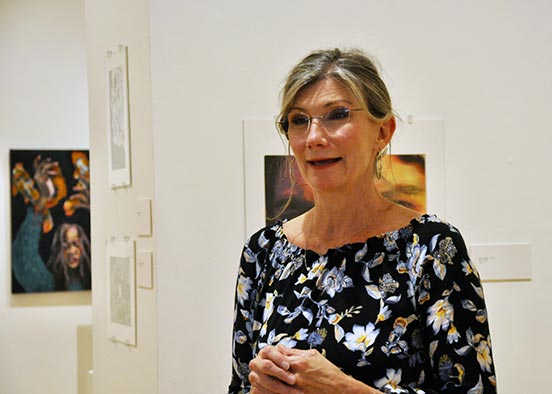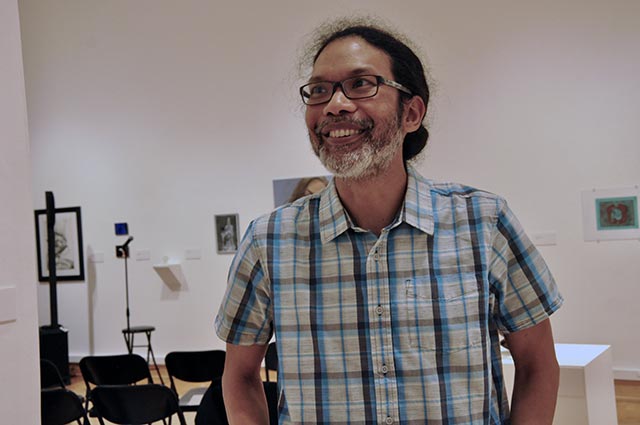Why do we tell stories? And how do we build a story good enough to share in front of an audience?
These are questions master storyteller Robin Schulte addressed during the recent FGCU Storytelling Series at the Wasmer Art Gallery.

“Part of it is being willing to be vulnerable, saying the things that people need to hear,” said Schulte, who traveled from Orlando to lead a storytelling workshop in March as part of the series. “It becomes a wellness journey for you and for all of us. Even if it’s never published, write about it.”
In addition to bringing in professional performers like Schulte from across the country, the storytelling program stages three student and faculty open-mic storytelling events each school year. Sponsored by the Seidler Fund and the Department of Language and Literature, the series covers an array of storytelling topics, inviting tellers who cross disciplines to engage a wide community audience. It is coordinated by Dr. Joel Ying, a medical doctor and adjunct in the Department of Integrated Studies, and Lori Cornelius, coordinator of creative writing in the Department of Language and Literature.
The seed for the series was planted after the two met at the Sanibel Island Writers Conference in 2014. “Joel is lovely and engaging, and we had been discussing the idea for years,” Cornelius said. “So, we decided, let’s just do it.”
Ying soon became a “storyteller in residence” at FGCU, and the series followed in 2019. As a doctor specializing in internal medicine, he sees storytelling as healing – a powerful way to talk about difficult personal topics and to convey experiences that touch a common thread with the audience.
“Storytelling connects everything that I do, it brings me alive,” Ying said. “Stories tell us that we are not alone. They bring meaning to life. We can apply the frame of storytelling to everything, how it fits into medicine and healing.”
As Cornelius puts it, “Storytelling helps us slow down a little bit. Stories are the one true thing that unite everyone and connect us.”
For the storytelling series to become a success, it needed the right location. Through campus partnerships, Ying united with FGCU Art Gallery Director John Loscuito.

“We talked about it and saw the potential for what we could do with it,” Loscuito said. “Just being there, with the storytellers and varied exhibitions … it’s opened the door to a symbiotic relationship. Two completely different forms of media, side by side, that creative influence.”
The series aims to encourage campus participation and promote storytelling as a community art as well as a performance art. “We had an additional goal of diversity and inclusion,” added Ying, who teaches a course called “Storytelling as Healing.” Students in the class are encouraged to perform.
Surrounded by more than 70 student artworks in the Wasmer Art Gallery, Schulte enveloped the audience with her March presentation. As an English teacher, she has always made storytelling an integral part of her classes. Earning an MFA in creative nonfiction writing from the University of Central Florida in 2020, she worked to figure out how to become a “performance-ready” storyteller.
“You always have to ask, ‘Whose story can you tell, and how do you tell it?’” Schulte said. “You have an obligation to share with the story subject, to be sure the way you’ve painted them is clear.”
Adding that music has a way of connecting us and driving nostalgia, she shared the experience of her first school dance. Bursting into song, Schulte elevated the story by incorporating tunes and lyrics, transporting the audience back to the 1980s. Her versions of hits such as “One Way or Another” by Blondie and “Come Sail Away” by Styx were woven through the story.
Establishing time and place and adding the cultural-research aspect is a key part of scene setting for a story, according to Schulte. “How you structure the story depends on the characters — just keep researching,” she said. “The narrator shows you in, and we can relate to and crave that connection. Personal narratives and story arcs are a way to really connect with people.”
As those connections are made, the storytelling series continues to sprout new ideas and participation, Loscuito said. “We now have art students participating and collaborating to create complementary pieces to provide props for stories,” he said.
With the series evolving and growing each year, Ying beams with pride when describing the impact that the initiative has made so far. “We’re building community around storytelling and exploring ideas that are stimulating,” he said.
- Watch the full performance: